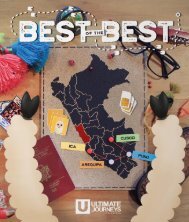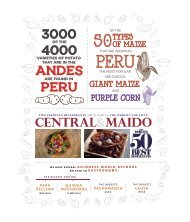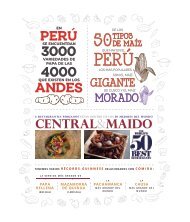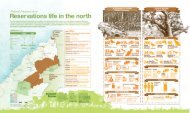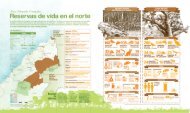UJ#5 Paracas
Create successful ePaper yourself
Turn your PDF publications into a flip-book with our unique Google optimized e-Paper software.
RESERVE OF LIFE<br />
White Egret<br />
(Egretta thula)<br />
THE PARACAS NATURAL RESERVE IS AN AREA OF ABOUT 113 SQUARE MILES WHERE THE DESERT MEETS THE OCEAN IN AN<br />
EXPLOSION OF LIFE. ALMOST ONE THIRD OF THE RESERVE IS DESERT THAT, MILLIONS OF YEAR AGO, WAS UNDER THE PACIFIC<br />
OCEAN UNTIL THE NASCA AND SOUTH AMERICAN PLATES COLLIDED AND THE ANDES MOUNTAINS WERE BORN.<br />
In this ancient territory characterized by beautiful geological<br />
formations created from water and wind, one can still find<br />
fossils of the whales and dinosaurs that once populated the<br />
region. There also are close to 100 archaeological sites left by the<br />
<strong>Paracas</strong> and Nasca people, both of whom developed societies<br />
based on agriculture, fishing and shellfish collecting. Their<br />
remains attest to societies able to adapt to their environment.<br />
Without doubt, it is the cold, Humboldt Current, densely<br />
inhabited by plankton, that constitutes the base for the complex<br />
food chain that allows a variety of sea animals - from penguins<br />
to whales – to flourish. There are 216 species of birds, between<br />
resident and migratory, 36 mammals, 10 reptile species and<br />
168 species of fish in the <strong>Paracas</strong> Reserve, making it the most<br />
bio diverse coastal area in Peru. Maybe the most surprising<br />
animal that makes an occasional appearance over the desert is<br />
the condor. Periodically, condors fly down to the coast from the<br />
Andes to hunt for marine life. That said, the animals most seen<br />
are foxes, sea lions, penguins, pelicans, seagulls, Inca tern,<br />
guanay cormorant and Andean flamingo, which have white<br />
bodies and red wings, inspiring José de San Martín, who led<br />
Peru`s War of Independence, to create the Peruvian flag.<br />
points along the Peruvian coast where birds congregate and<br />
guano is produced in large amounts. In the end of the 19th<br />
Century, Peruvian guano exportation made economic history<br />
for the country. Unfortunately, is also led to the environmental<br />
destruction of many coastal areas. Today, thanks to the creation<br />
of the Reserve, an effort is being made to find a balance between<br />
conservation and the extraction of this important resource,<br />
creating a sustainable business for Peruvians that also respects<br />
the area’s ecological health.<br />
The <strong>Paracas</strong> National Reserve represents a breath of fresh air<br />
in the face of human development and the growth of cities. The<br />
Reserve allows visitors a chance for an up close look at the<br />
desert, the ocean, the sky and their inhabitants; and, with each<br />
gust of wind, it reminds us that once in the distant past all of<br />
this was untouched.<br />
One of the most popular tourist sites in <strong>Paracas</strong> are the<br />
Ballestas Islands, a group of small islands where a variety of<br />
birds live among a large sea lion colony. The Ballestas also are<br />
a part of the National Reserve of Islands and Guano Points,<br />
a conservation Project that includes 22 small islands and 11<br />
50%<br />
OVER 50% OF ALL SEA<br />
LIONS IN PERU LIVES IN<br />
THE PARACAS NATIONAL<br />
RESERVE.<br />
Above: View of San Gallan Island, one of<br />
the Reserve’s important areas known for<br />
its biodiversity.<br />
Left: Red-Legged Cormorant<br />
(Phalacrocorax gaimardi) with its chick.<br />
Right: Guanay Cormorants are the best<br />
producers of guano, a highly valued,<br />
agricultural fertilizer.<br />
Opposite page: The Peruvian Pelican<br />
reproduces on islands close to the coast<br />
that are bathed in the cold waters of the<br />
Humboldt Current.




